The diets of Central Europe have been relatively understudied in the field of food studies, particularly when compared to the cuisines of France and Italy. While extensive research has been conducted on culinary cultures from other regions, such as France and Italy, the cuisines of Central European countries like Austria, Czech Republic, Hungary, Poland, and more have not received as much attention. However, there is a growing interest in studying the food history and culture of Central Europe, with the aim of bringing together scholars and developing long-term cooperation between researchers and institutions. The importance of increasing awareness and knowledge about the past and present diets of Central Europe cannot be overstated, as it holds the potential to establish Central Europe as an important area of study in the field of food studies.
Key Takeaways
- The diets of Central Europe have been relatively understudied in the field of food studies.
- Central European cuisines have not received as much research attention compared to French and Italian cuisines.
- There is a growing interest in studying the food history and culture of Central Europe.
- Increasing awareness and knowledge about Central European diets is essential for developing the field of food studies.
- Central Europe has the potential to become an important area of study in the field of food studies.
Historical Diets in Central Europe
Central Europe has a rich history of diverse culinary traditions, with its historical diets shaped by a blend of cultural influences and regional resources. Throughout the centuries, the countries of Central Europe, including Austria, Czech Republic, Hungary, Poland, and more, have developed unique cuisines that reflect their cultural and historical backgrounds.
The diets of Central Europe have been influenced by neighbouring countries, historical events, and migration patterns, resulting in a range of flavours and ingredients that have stood the test of time. Traditional dishes often feature staple ingredients such as potatoes, cabbage, pork, and bread, which were readily available in the region.
One iconic example is the Czech dish of goulash, a hearty stew traditionally made with beef, onions, and paprika. This dish showcases the influence of neighbouring countries, as it originated from Hungarian cuisine but is now a staple in Czech culinary traditions. Similarly, Poland is famous for its pierogi and dumplings filled with various ingredients such as potatoes, cheese, or meat, which highlight the country’s agricultural heritage.
By exploring the historical diets of Central Europe, we can gain insight into the cultural and culinary heritage of this region. It is through understanding the past that we can appreciate the present and preserve the rich traditions that have shaped Central European cuisine over centuries.
| Country | Iconic Dish |
|---|---|
| Austria | Sachertorte |
| Czech Republic | Goulash |
| Hungary | Goulash |
| Poland | Pierogi |
Central European Cuisine in Quotes:
“Central European cuisine is a testament to the region’s rich history and cultural diversity. It offers a tapestry of flavors and culinary traditions that have been passed down through generations.” – Food historian, Dr. Anna Novak
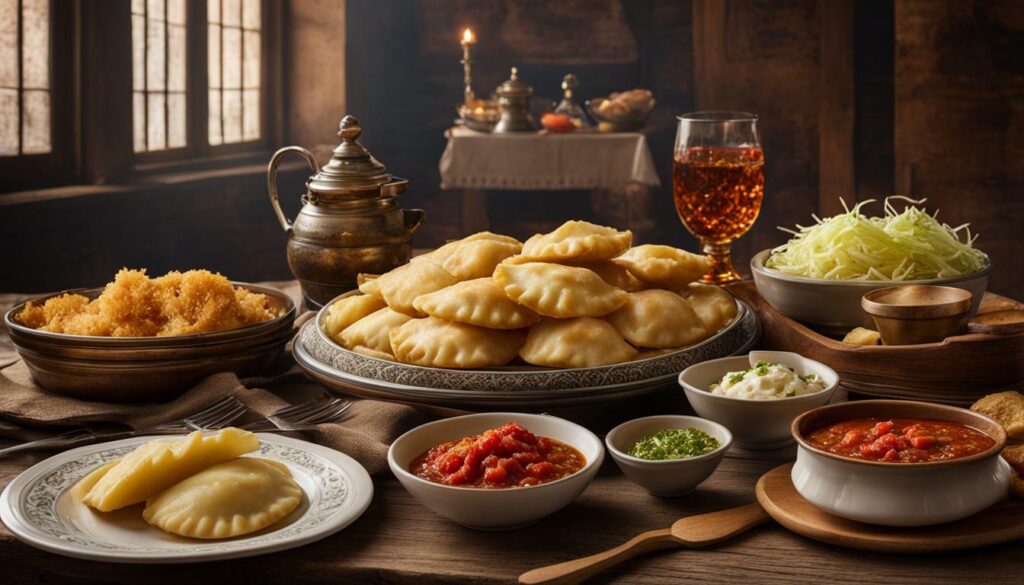
- Central Europe has a rich history of diverse culinary traditions.
- Historical diets were shaped by cultural influences and regional resources.
- Traditional dishes like goulash and pierogi showcase Central European flavours.
- Preserving and understanding the past is crucial for appreciating present-day cuisine.
Traditional Central European Foods
Traditional Central European foods offer a delightful blend of flavours and textures, with each country in the region boasting its own array of iconic dishes. From hearty stews and dumplings to delectable pastries and sausages, the culinary traditions of Central Europe have been shaped by its rich history and diverse cultural influences. Let’s take a closer look at some of the traditional foods that have become synonymous with Central European cuisine.
Polish Pierogi: These delicious dumplings are a staple in Polish cuisine. They are typically filled with a variety of ingredients such as potato, cheese, sauerkraut, mushrooms, or meat. Pierogi can be boiled, fried, or baked, and are often served with sour cream or melted butter. They are a beloved comfort food in Poland and can be found in many homes and restaurants throughout the country.
“Pierogi are more than just a dish – they represent Polish hospitality and the warmth of family gatherings,” says renowned Polish chef, Anna Majewska.
Austrian Wiener Schnitzel: This iconic dish consists of a breaded and fried veal escalope, pounded thin and served with a slice of lemon. It originated in Vienna and has since become a popular dish across Central Europe. The schnitzel is typically accompanied by traditional Austrian sides like potato salad or spaetzle, and is enjoyed by locals and tourists alike.
Hungarian Goulash: Known for its rich and hearty flavours, Hungarian goulash is a meat stew made with tender chunks of beef, onions, paprika, and other spices. It is usually served with potatoes or noodles and is considered one of Hungary’s national dishes. The dish has a long history and is deeply rooted in Hungarian culture and cuisine.
Traditional Central European Recipes
These are just a few examples of the traditional foods that showcase the diverse and delicious cuisines of Central Europe. Each country in the region has its own unique dishes and culinary traditions that have been passed down through generations. Exploring the flavours and techniques of Central European cooking opens up a world of gastronomic delights and cultural experiences.
| Country | Iconic Dish |
|---|---|
| Poland | Pierogi |
| Austria | Wiener Schnitzel |
| Hungary | Goulash |
| Czech Republic | Trdelník |
| Slovakia | Bryndzové Halušky |
These iconic dishes represent the essence of Central European cuisine and are a testament to the region’s rich culinary heritage. Whether you’re savouring a plate of pierogi in Poland, indulging in a schnitzel in Austria, or enjoying a bowl of goulash in Hungary, you’re experiencing the flavours and traditions that have been passed down through generations.
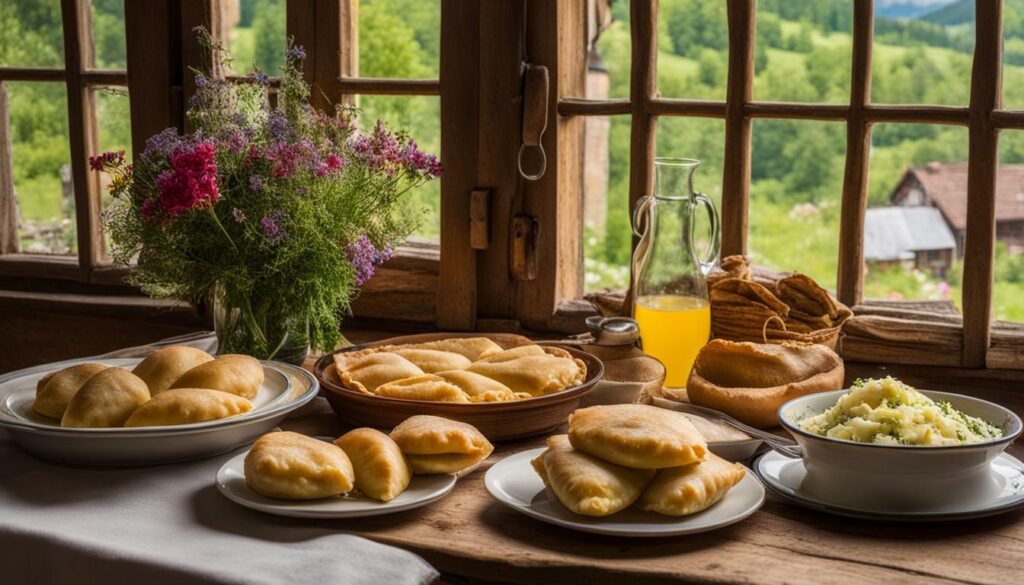
Central European cuisine is a treasure trove of traditional recipes and culinary delights. By embracing and celebrating the past and present diets of Central Europe, we can preserve and promote the rich food culture of this diverse region for generations to come.
Cultural Influences on Central European Diets
Central European diets have been heavily influenced by the cultures and cuisines of neighbouring countries, resulting in a unique culinary tapestry that reflects a rich history of cross-cultural pollination. The region’s geographical location and historical events have played a significant role in shaping its food culture and traditions.
One of the most influential neighbouring countries on Central European diets is Germany. The close proximity and shared border have led to the exchange of culinary practices and ingredients. German influences can be seen in dishes such as sausages, pretzels, and sauerkraut, which have become staples in Central European cuisine. Similarly, Austria has had a profound impact on its neighbouring countries, particularly in terms of pastries and coffee culture.
The Ottoman Empire’s historical presence in Central Europe also left a lasting mark on the region’s food culture. The introduction of ingredients such as paprika, coffee, and various spices brought new flavours and techniques to Central European kitchens. Hungarian cuisine, in particular, showcases the influence of Ottoman traditions, with dishes like goulash and paprikash becoming synonymous with the region.
Furthermore, the Austro-Hungarian Empire played a pivotal role in shaping Central European culinary traditions. The empire’s diverse territories brought together a fusion of ingredients, cooking methods, and flavours, resulting in a rich and varied food culture. The legacy of this empire can still be seen in the wide range of dishes and culinary techniques that are celebrated in Central European cuisines today.
Table: Cultural Influences on Central European Diets
| Country | Cultural Influence |
|---|---|
| Germany | Sausages, pretzels, sauerkraut |
| Austria | Pastries, coffee culture |
| Ottoman Empire | Paprika, coffee, spices |
| Austro-Hungarian Empire | Fusion of ingredients, cooking methods, and flavours |
With such diverse cultural influences, Central European cuisine has blossomed into a vibrant tapestry of flavours and traditions. Exploring the cross-cultural exchange that has shaped the region’s diets allows us to appreciate the dynamic nature of Central European food culture and the multitude of influences that have contributed to its unique identity.
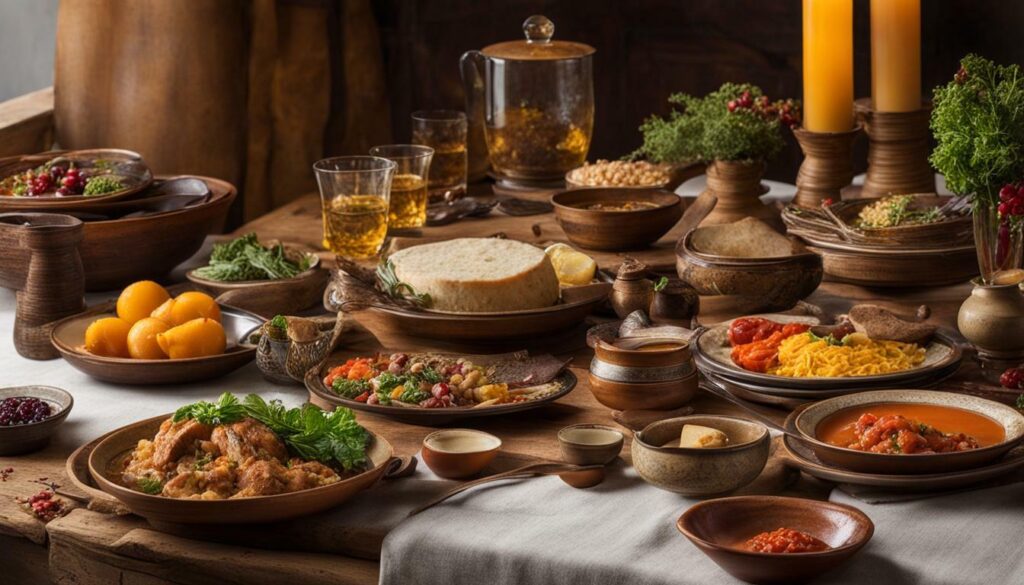
Evolution of Central European Diets
Over the centuries, Central European diets have undergone significant changes, adapting to societal shifts, advancements in technology, and the introduction of new ingredients and cooking techniques. This evolution has shaped the region’s culinary landscape, giving rise to a diverse array of traditional and modern dishes that continue to delight locals and visitors alike.
One of the key factors influencing the evolution of Central European diets is the region’s complex history and cultural influences. Countries like Austria, Czech Republic, Hungary, Poland, and others have been influenced by neighbouring regions and experienced periods of foreign rule, resulting in the fusion of various culinary traditions. These influences can be seen in the rich flavours and unique combinations found in popular Central European dishes.
The introduction of new ingredients and cooking techniques has also played a significant role in shaping Central European diets. The discovery of the New World and the subsequent exchange of goods and ideas during the Age of Exploration brought a wide range of ingredients, such as potatoes, tomatoes, and peppers, which were quickly incorporated into Central European cuisines. This led to the development of iconic dishes like goulash, schnitzel, and pierogi, which have become synonymous with Central European cuisine.
Furthermore, advancements in technology, such as the invention of refrigeration and the development of transportation networks, allowed for greater accessibility to a wider variety of ingredients. This led to further diversification in Central European diets, as people had more options and could experiment with different flavours and ingredients. Traditional staples like bread, meat, and dairy products remained important, but the availability of fruits, vegetables, and spices increased, adding new dimensions to Central European cooking.
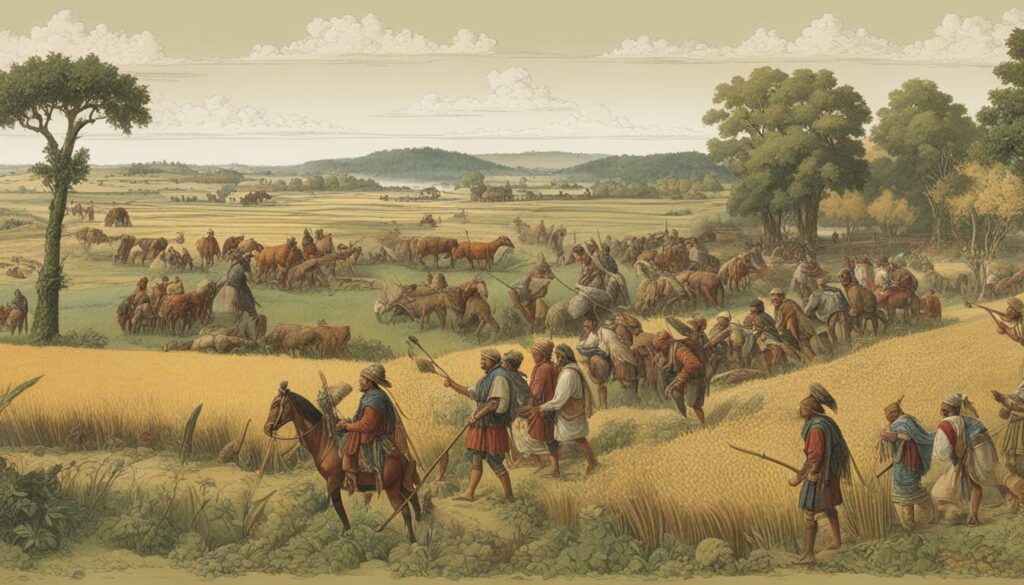
| Dish | Country of Origin |
|---|---|
| Sauerbraten | Germany |
| Goulash | Hungary |
| Pierogi | Poland |
| Schnitzel | Austria |
| Česnečka | Czech Republic |
These are just a few examples of the popular Central European dishes that have emerged as a result of the region’s culinary evolution. Each dish carries a unique story and reflects the diverse cultural influences that have shaped Central European cuisine over time. As Central Europe continues to embrace its rich food heritage while also embracing modern culinary trends, the evolution of its diets will undoubtedly continue, offering new and exciting flavours for generations to come.
Staple Foods in Central Europe
Central European diets are characterized by a variety of staple foods that have been nourishing the people of the region for generations. These staple foods form the foundation of Central European cuisine and are essential components of the regional food culture. From hearty grains to flavorful meats and cheeses, Central Europeans have relied on these traditional ingredients to create delicious and fulfilling dishes.
One of the most common staple foods in Central Europe is bread. With a rich history and a diverse range of bread types, bread holds a special place in the hearts of Central Europeans. Rye bread, in particular, is a beloved staple, known for its dense texture and slightly sour taste. It is often served with a variety of toppings such as butter, cheese, or cured meats.
Another staple food in Central Europe is potatoes. Potatoes are incredibly versatile and can be prepared in a multitude of ways. Whether boiled, mashed, or roasted, they feature prominently in traditional Central European dishes such as potato dumplings, potato pancakes, and hearty potato soups.
The region’s staple foods also include various types of meats such as pork, beef, and poultry. Central Europeans have a long-standing tradition of consuming meat in their diets, and it is often the centrepiece of meals. Cured meats, sausages, and stews are popular dishes that showcase the rich flavours and culinary expertise of the region.
Explore the rich and diverse culinary heritage of Central Europe by incorporating these staple foods into your own cooking. Whether you’re enjoying a warm slice of freshly baked bread or savouring a hearty potato dish, these traditional ingredients will transport you to the heart of Central European cuisine.

| Staple Foods | Description |
|---|---|
| Bread | A variety of bread types, including rye bread, are a central part of the region’s cuisine. |
| Potatoes | Versatile and widely used in traditional dishes such as dumplings, pancakes, and soups. |
| Meats | Pork, beef, and poultry are commonly consumed meats in Central European diets. |
| Cheese | Central Europe is known for its diverse range of cheeses, including Swiss, Gouda, and feta. |
Modern Day Cuisines in Central Europe
Central European cuisines continue to evolve, with modern-day culinary practices blending traditional flavours and techniques with innovative approaches to cooking. The countries of Central Europe, including Austria, Czech Republic, Hungary, Poland, and others, boast a rich and diverse food culture that reflects their history, geography, and cultural influences.
One notable aspect of modern Central European cuisines is the revival of traditional recipes and ingredients. Chefs and home cooks alike are rediscovering age-old dishes and giving them a contemporary twist. For example, classic Hungarian goulash, a hearty stew usually made with beef and paprika, is now being reinvented with alternative meats and locally sourced organic ingredients.
Furthermore, fusion cuisines are gaining popularity, combining traditional Central European flavours with global culinary influences. This has resulted in delicious and inventive dishes, such as Polish pierogi filled with Asian-inspired ingredients or Czech schnitzels served with Middle Eastern pickles and sauces.
Exploring Central European Delicacies
In addition to the fusion of flavours, Central European cuisines are also embracing modern cooking techniques and presentation styles. Chefs are experimenting with molecular gastronomy, incorporating new textures and visual elements into their dishes. This innovative approach to food preparation has elevated traditional Central European recipes to new heights, attracting a younger generation of food enthusiasts and international recognition.
One example of this culinary evolution is the reinvention of the Austrian dessert, Sachertorte. Originally a simple chocolate cake, it has been reimagined by modern pastry chefs using avant-garde techniques and artistic plating. The result is a visually stunning dessert that honours its heritage while appealing to contemporary tastes.
Overall, the modern-day cuisines of Central Europe offer a delightful blend of tradition and innovation. Whether you’re indulging in hearty stews, exploring intricate pastries, or savouring fusion creations, there is no shortage of culinary delights to discover in this vibrant and evolving region.
| Traditional Dish | Modern Interpretation |
|---|---|
| Polish Pierogi | Stuffed with Asian-inspired fillings, such as kimchi or tofu |
| Austrian Wiener Schnitzel | Served with Middle Eastern pickles and tahini sauce |
| Czech Trdelník | Infused with unique flavours like matcha or rosewater |
| Hungarian Goulash | Reinvented with alternative meats and seasonal vegetables |
Central European cuisines continue to evolve, with modern-day culinary practices blending traditional flavors and techniques with innovative approaches to cooking.
Dietary Habits in Central Europe
Central European dietary habits are deeply rooted in cultural traditions and reflect a strong sense of community and togetherness. Food plays a significant role in daily life, celebrations, and festivals, often bringing families and friends together to share meals and create lasting memories.
One notable aspect of Central European food culture is the emphasis on hearty and filling meals. Traditional dishes are often rich in flavours and textures, incorporating ingredients such as potatoes, cabbage, meats, and dairy products. These elements are combined to create comforting and satisfying dishes that are enjoyed by locals and visitors alike.
Furthermore, dining etiquette is an important part of Central European dietary practices. It is customary for people to gather around the table and engage in leisurely meals, taking the time to savour each bite and engage in meaningful conversations. Communal dining fosters a sense of unity and allows individuals to connect on a deeper level, reinforcing the importance of shared experiences in Central European food culture.
“Food is not just nourishment in Central Europe; it is a way of connecting with our roots, preserving traditions, and celebrating our shared heritage.”

In Central Europe, there is a strong emphasis on using locally sourced ingredients in cooking. Farm-to-table practices are highly valued, with many households growing their own fruits, vegetables, and herbs. This commitment to using fresh, seasonal produce not only enhances the flavours of dishes but also promotes sustainability and supports local farmers.
Central European cuisine also celebrates the abundance of wild ingredients available in the region’s forests and countryside. Mushrooms, berries, and herbs are foraged and incorporated into traditional recipes, adding a unique and natural touch to the culinary offerings.
A Blend of Traditions and Modern Influences
While Central European dietary habits have deep historical roots, there is also a growing acceptance of modern influences in the region’s food culture. The younger generation embraces international cuisines, experimenting with new flavours and techniques while still incorporating traditional elements into their dishes.
This fusion of tradition and innovation can be seen in the vibrant culinary scene of Central Europe’s cities, where innovative chefs and food entrepreneurs are reimagining traditional recipes with a contemporary twist. This culinary evolution ensures that Central European food culture remains dynamic and relevant in today’s globalized world.
| Traditional Central European Foods | Countries |
|---|---|
| Schnitzel | Austria |
| Goulash | Hungary |
| Pierogi | Poland |
| Knödel | Czech Republic |
| Sauerkraut | Germany |
Central European dietary habits and food culture provide a glimpse into the region’s rich history, diverse traditions, and the values that are cherished by its people. Exploring the past and present diets of Central Europe not only satisfies gastronomic curiosity but also deepens our understanding of the cultural heritage that shapes the way we eat and enjoy food today.
Central European Food Culture
Food plays a central role in the cultural fabric of Central Europe, serving as a cornerstone of celebrations, rituals, and everyday life. The diverse cuisines of countries like Austria, Czech Republic, Hungary, Poland, and more reflect the rich history and traditions of this region. Central European food culture is characterized by its hearty and flavoursome dishes, influenced by a combination of local ingredients, cultural influences, and historical events.
One of the defining aspects of Central European food culture is the emphasis placed on communal dining. Sharing a meal with friends and family is seen as a way to connect, communicate, and create lasting memories. Festive occasions like Easter and Christmas are marked by elaborate feasts, with tables filled with traditional dishes that have been passed down through generations. This communal aspect of dining fosters a sense of togetherness and highlights the importance of food in nurturing relationships.
Central European cuisine history is also shaped by the region’s geographical location and historical influences. Situated at the crossroads of Europe, Central Europe has long been a melting pot of cultures, resulting in a culinary tapestry that blends elements from neighbouring countries. For example, Hungarian cuisine is known for its spicy flavours influenced by Turkish and Balkan cuisines, while Austrian cuisine incorporates elements from both German and Italian culinary traditions.
This rich culinary heritage is celebrated through traditional dishes that are still enjoyed today. From Wiener Schnitzel in Austria to goulash in Hungary and pierogi in Poland, Central European cuisine showcases a wide range of flavours and ingredients. These iconic dishes form an integral part of the region’s food culture and are often prepared using age-old recipes that have been passed down through generations.
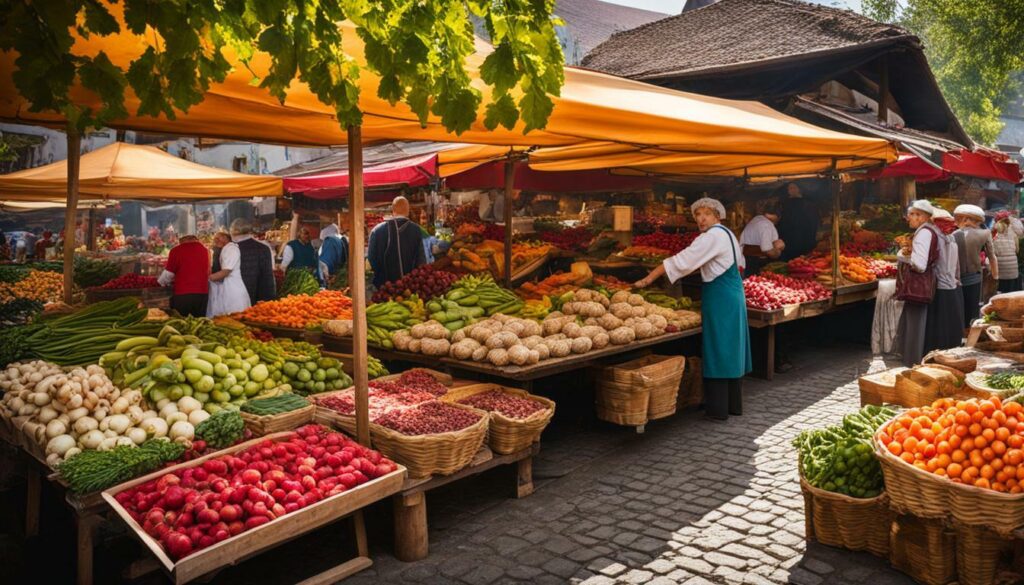
- Wiener Schnitzel: A classic Austrian dish made from breaded and pan-fried veal or pork cutlets. Served with lemon wedges and potato salad, it is a popular choice in traditional Viennese cuisine.
- Goulash: A hearty Hungarian stew made with chunks of beef, onions, and paprika. Often accompanied by dumplings or served over egg noodles, goulash is a staple in Hungarian households.
- Pierogi: A beloved Polish dumpling filled with various savoury or sweet fillings, such as cheese, potato, sauerkraut, or fruit. Pierogi are typically boiled or fried and served with sour cream or melted butter.
Central European food culture is a treasure trove of flavours and traditions, offering a glimpse into the region’s rich history and heritage. Exploring the past and present diets of Central Europe allows us to appreciate the diverse culinary tapestry that has shaped this vibrant region.
Conclusion
Exploring the past and present diets of Central Europe reveals a rich culinary history and a diverse range of flavours and traditions that deserve further recognition and study in the field of food studies. Despite being a neglected field in food research, the cuisines of countries like Austria, Czech Republic, Hungary, Poland, and more have their own unique culinary cultures that have not received much attention compared to cuisines from other regions like France and Italy.
However, there is a growing interest in studying the food history and culture of Central Europe, with scholars and institutions coming together to develop long-term cooperation and research collaborations. By increasing awareness and knowledge about the past and present diets of Central Europe, it is hoped that this region will become an important area of study in the field of food studies.
With its historical diets, traditional foods, cultural influences, and evolving culinary trends, Central Europe offers a fascinating exploration of the connections between food, culture, and identity. From staple foods that form the foundation of the region’s cuisine to the fusion of traditional and modern elements in contemporary recipes, Central Europe showcases a rich tapestry of culinary traditions and practices.
Therefore, it is crucial to preserve and document the culinary heritage of Central Europe for future generations. By recognizing the value of Central European cuisines throughout history and in the present, we can ensure that this region receives the recognition and study it truly deserves in the field of food studies.
FAQ
What is the focus of this article?
This article focuses on exploring the diets of Central Europe, specifically the cuisines of countries like Austria, Czech Republic, Hungary, Poland, and more, throughout history and in the present day.
Why has the study of Central European diets been neglected in food studies?
Central European culinary cultures have not received much attention in food studies, unlike cuisines from other regions like France and Italy. However, there is a growing interest in studying the food history and culture of Central Europe.
What is the aim of studying Central European diets?
The aim is to increase awareness and knowledge about the past and present diets of Central Europe, with the hope of making this region an important area of study in the field of food studies.
What will be discussed in the section about historical diets in Central Europe?
The section will delve into the culinary traditions and dietary practices that were prevalent in Central Europe throughout the centuries, exploring the cultural influences and evolution of these diets.
What can I expect to learn about traditional Central European foods?
This section will highlight some of the traditional foods that have been an integral part of Central European cuisine for generations, showcasing iconic dishes and recipes that are still enjoyed today.
How have cultural influences shaped Central European diets?
Cultural influences from neighbouring countries, historical events, and migration patterns have played a significant role in shaping the culinary traditions and dietary practices of Central Europe.
How have Central European diets evolved over time?
This section will explore the factors that have influenced the changing food trends, dietary habits, and the emergence of popular dishes in Central Europe.
What are the staple foods in Central Europe?
The staple foods in Central Europe form the foundation of its diets. This section will explore the traditional ingredients and dietary practices that have been integral to the region’s food culture.
What will be discussed in the section about modern day cuisines in Central Europe?
The section will highlight the contemporary recipes and culinary trends that have emerged in recent years, showcasing the fusion of traditional and modern elements in Central European cooking.
What are the dietary habits in Central Europe?
This section will delve into the prevalent dietary habits and customs in Central Europe, exploring the cultural significance of mealtimes, food rituals, and the importance of communal dining.
What will be covered in the section about Central European food culture?
The section will provide an overview of the food culture in Central Europe, exploring the role of food in celebrations, festivals, and everyday life, as well as the connection between food and identity in the region.
Source Links
- https://www.ncbi.nlm.nih.gov/pmc/articles/PMC9460423/
- https://www.academia.edu/37150053/Food_in_Central_Europe_Past_Present_Memory_Aleksandra_Drzał_Sierocka_Magdalena_Tomaszewska_Bolałek_eds_
- https://www.ncbi.nlm.nih.gov/pmc/articles/PMC4880197/



